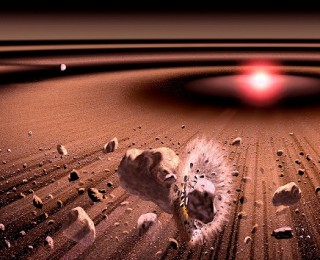by Vatsal Panwar | Apr 17, 2019 | Daily Paper Summaries
How, and when does the wavelength dependence of photospheric radius of an eclipsing exoplanet become too important to neglect?

by Jaime Green | Mar 4, 2015 | Daily Paper Summaries
Hot Jupiters are weird and lonely. Is gravitational perturbation to blame?

by Jaime Green | Apr 23, 2014 | Daily Paper Summaries
Earth and its Solar System compatriots all have nearly circular orbits, but many exoplanets orbit their stars on wildly eccentric paths. Is our home system strange? Or is our sense of the data skewed?

by Sukrit Ranjan | Aug 16, 2013 | Daily Paper Summaries
There is a small planet candidate, likely rocky, that looks like it’s being vaporized. The authors of this paper show evidence that this evaporation might be related to stellar activity, not just the planet’s proximity to its star.

by Sukrit Ranjan | Nov 14, 2012 | Daily Paper Summaries
Paper Title: Comet-Like Mineralogy of Olivine Crystals in an Extrasolar Proto-Kuiper Belt (arxiv: 1211.2626) Authors: B. L. de Vries et al First Author’s Affiliation: K. U. Leuven, Flanders, Belgium Journal: Nature OverviewThis paper describes observations of the mineral olivine in the famous debris disk surrounding the star Beta Pictoris. Olivine is very important as it is one of the primary building blocks of rocky planets. They find its composition and temperature to match what we find in our outer solar system, hinting that we are spying on a proto-Kuiper belt. The similarity between solar systems suggests similar processes may be operating in other systems as happened here around Sol.More DetailIn the past decade, we’ve made huge advances in remote characterization of planetary bodies. From the atmospheres of exoplanets to the surfaces of asteroids, astronomers have conducted some pretty extraordinary measurements (for example, the discovery of Alpha Centauri Bb, which entailed measuring the motion of Alpha Cen to 51 cm/s — a slow walk!). However, most of these measurements have been surface measurements. It’s much harder to study the interiors of objects, because we don’t receive photons from them.There are exceptions, though. Consider a young planetary system with plenty of asteroids. These asteroids will run into each other, shattering apart and generating dust. Light passing through these dust clouds will then have their spectral signature imprinted on them, letting us study their interior composition!Astronomers have discovered several such systems, allowing us for the first time to characterize the interior composition of rocky bodies remotely. This paper presents the results of the latest such study, on the system Beta Pictoris. Beta...

by Sukrit Ranjan | Apr 10, 2011 | Daily Paper Summaries
This eye-catching theory paper asks an elegant but simple question: when dark matter is gravitationaly captured by a planet, can the energy released when it annihalates provide enough heat to make the planet habitable?




